Since 1999

Cartridge Substitution Help! - Replacing Cartridges No Longer Available
![]()
Way back when, there were 800 or so different ceramic and crystal cartridges available for replacement use
with varying mounting styles, tracking forces, pin/plug connections, and outputs. Today there are only
a handful of low output ceramic cartridges still being made. If the cartridge you need is no longer available
as new old stock, it becomes necessary to use / adapt one of the available cartridges.
How to use this page: First, check the Cartridge main page by using one of the search methods
provided. Look also in the Cartridge Kits menu for replacement kits that may be available for popular
models, such as Magnavox. The RCA 45 players have their own page, the V-M and RCA 45 Player parts
page; kits for these shown at the bottom. Contact us by email for availability of less popular cartridges where we
may still have stock. Otherwise, click on one of the links below:
Ceramic (and low output crystal) cartridges were the most diverse in terms of mounting styles and pin/plug configurations so physical modification to mount a replacement is the primary consideration. Here, we are talking about cartridge outputs generally in the 0.2 to 1.3 volt range, and tracking force 10 grams or under.
The principles to keep in mind for substitution are as follows:
1. Output voltage - A 0.5v cartridge can substitute for most with acceptable volume. For cartridges at the upper end of the range (1.0 volt and higher), an experienced technician can sometimes modify the amplifier to get a little more gain, and better bass response. We cannot advise on how to do this.
2. Tracking force - Cartridges today are available tracking in the range from 3 to 8 grams. Select one that has a range that is closest to the original cartridge's tracking force requirement. Adjusting the tracking force on a record player or record changer is easy on some models, and more difficult on others. We cannot advise on how to do this for brands other than V-M so get the service manual. Sometimes weights can be glued in the tone arm to increase weight. Making a model track a little lighter may be more difficult, if there is not a counter weight spring in the design.
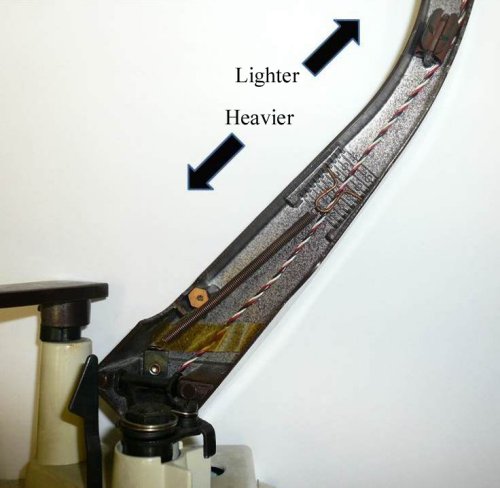
Adjust force on an older V-M by moving spring clip as shown
3. Needle tip placement - the principle is to mount the cartridge in such a way that the tip of the needle that actually touches the record is approximately in the same position (in all three dimensions) in the retrofit, as it was in the original installation. Exactness is not required. In the example shown at right, the replacement tip is a little farther towards the end of the tone arm than the original and that is acceptable. Replacement ease depends on the mounting style of the original, discussed as follows:
 Example of replacing a single screw mount turnover cartridge |
a) Cartridges with half inch mount - this means a cartridge with two screws, and
the screw hole centers are spaced one half inch apart. This is the easiest
situation and the replacement cartridge may be able to be installed without modification.
In some cases, spacers may be needed in models with tall tone arm headshells
so that the flip needle does not strike the side of the tone arm, and again, the
tip of the needle is close to being in the same place as before. b) Cartridges with 5/8 inch mount - many RCA record players fall into this category. Longer screws with spacers can sometimes be used to "spread across" the increased distance to make a half inch mount style cartridge work. For the RCA 45 players, see the V-M and RCA 45 Player Parts page, where kits are offered to replace original low output cartridges. |
c) Cartridges with special mounting designs - Many Telefunken, Grundig and other European designs, along with some RCA models may have original cartridges that snap-in or are on a floating bracket type arrangement, or have some other mounting style that does not involve using two screws. These require some creativity. It may be necessary to remove bracketry and glue in a mounting "pad" made from scrap pieces of plastic that the replacement cartridge's mounting bracket can be glued to. A Telefunken example is shown below.
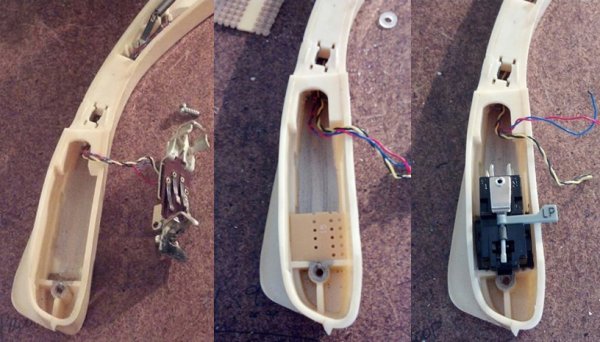
Three stages of Telefunken modification to accept P226 ceramic cartridge
|
4. Pin / plug connections. All the current cartridges have
four round pins. It will be necessary to either replace the
entire tone arm wire assembly (see Cartridge Installation
Parts page and search on Tone Arm Wire) or solder new clips
onto the existing tone arm wire. Round clips or clip and
wire extensions are supplied with current production
cartridges. Some phonos may have less than four tone arm
wires, see below: a) Three wire arrangement. In this situation, there is a common ground. Either wrap a bare wire around the two ground pins tightly and attach tone arm wire to only one pin, or make a jumper to connect the two grounds together as shown in the photo at right. b) Two wire arrangement (mono). Click on Stereo cartridge replacing a monaural cartridge to go to where this conversion is discussed. |
 P191 Magnavox cartridge replacement 4 pins 3 wires |
The following are the cartridges that we believe will be around for awhile. Replacement needles will also be available for the foreseeable future.
All of the following can be found on the Cartridges page. Use the Search by Cartridge Brand menu, select Pfanstiehl® and click GO:
• Pfanstiehl® and EVG varco replacements sold under various numbers, on this website sold as P132, P226 and P228. These are all the same cartridge body today, the only difference is the P228 which is sold with short 4 conductor tone arm wires with clips for use in replacing monaural cartridges and an 865 shorter cantilever needle to boost its output. These have flip over needles which makes them very popular.
• Chuo Denshi P188 and P190 series. Although listed as 0.35v output, this cartridge tends to "overachieve" and sounds as loud as the P132/P226 and P192. It also does the best job of tracking modern records, and a needle with a 3.0 mil tip can be ordered on the Needles/Styli page for playing 78 rpm records.
• Pfanstiehl® P51 with half inch mount bracket. This monaural cartridge is popular with juke box owners and is also available in versions with 0.7, 2, and 3 mil single tip needles.
• P192D is based on BSR SC7M1, SC8H1 body style but does not have molded BSR single screw mount. Included bracket does have a hole for single screw mount. Compared to P132/P226, this has a narrow profile that can be used in some narrow tone arms, but not as narrow as Tetrads. Tracks light and has advantage of playing modern records like P188 and P190 series but with flip needle.
Ceramic Cartridge Replacement - Tetrad Brand
| After 1965, many record player manufacturers switched to using cartridges from the Tetrad Company.
These can be recognized by their compact size and small four pin plug that plugs into the rear. Their modular design, reasonable price, and range of outputs made them very popular. The basic element could be used as-is, typically glued into a manufacturer's custom designed plastic or metal headshell, or glued to a mount of the manufacturer's choosing - standard half inch mount, "snap-in" mount, and a special single screw mount for BSR record changers were the three most popular mounts. Tetrads are now obsolete but we have a good stockpile. To see the Tetrad offerings, on the Cartridges page, Search by Cartridge Brand and select Tetrad and click GO. • The original wire harness can be used as they are wired as Tetrads. Available as shown, standalone or with a mount of your choosing. • Pfanstiehl® P400 series: these are obsolete and not available here. If you are using obsolete stock, be advised that they do not follow the Tetrad design in terms of how they are wired. |
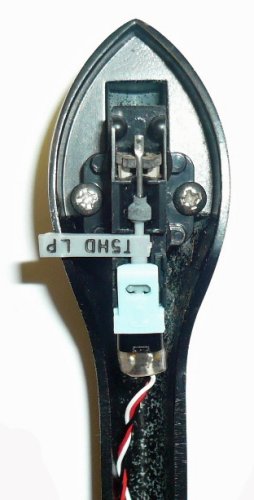 Tetrad with half inch mount will fit |
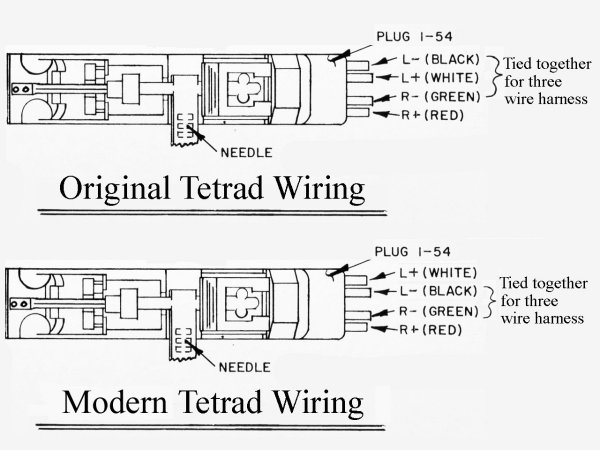
The output voltage is the next consideration. With the Tetrads currently available, the output voltage can be determined by needle choice as follows:
| Basic needle (any handle length) |
Approximate output voltage |
|
| 853 854 855 856 |
0.5v 0.39v 0.28v 0.18v |
|
Default is to supply with an M854 or M855 needle as indicated in listings, but if you advise that you want a different needle, and include make and model information on the shopping cart order page, then the order will be filled with that needle. Be sure to click SAVE/UPDATE button below the box containing this information before proceeding to checkout, or the information will be lost!
For the technically inclined: Tetrads in the past were available in capacities ranging from 550pf to 7000pf. Today, offerings span these offerings in 3 groups (EV5632, EV5633, and EV5634 series) while supplies last.
Crystal Cartridge Replacement
The situation here falls into three groupings.
• If the cartridge to be replaced is a one volt or less model, tracking under 10 grams, then follow the guidance given in the Ceramic cartridge section.
• If the old cartridge has a higher output rating above a volt and suitable replacements have sold out, and if the tracking force is 10 grams or less, a ceramic cartridge can be used if the amplifier is modified with an additional amplification stage. Some professionals can do this. We cannot advise on this further, except to say that magnetic phono preamps sold on this website and others, cannot be used for this purpose.
• In early 20th century models with record changers and crystal cartridges of any output, the issue here becomes the tracking force requirement. Some of these require an ounce or more of tracking force or the record changer will not "trip" and perform automatic functions. In this situation, rebuilding the present cartridge with a new crystal would be the choice. We do not do cartridge rebuilding . Another alternative would be to disable the automatic functions, lighten the tone arm and follow one of the situations above to replace the cartridge. The player would then work in manual mode only.
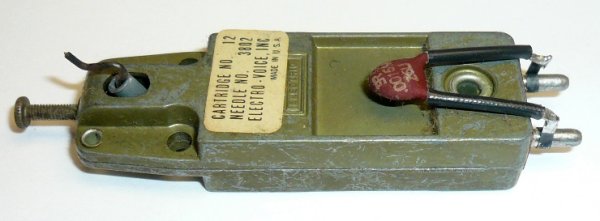
Example of old style heavy tracking cartridge - there may be no modern substitute
Magnetic Cartridge Replacing a Crystal or Ceramic Cartridge
This is the most problematic situation of all and we really cannot advise on the feasibility of doing this by model. We only have experience with certain V-M changers with metal tone arm and headshell designed to accept a half inch mount cartridge. The issues are many, and detailed below:
• Hum. Models with magnetic cartridges generally have 4 pole motors, better suited to keeping magnetic fields away from the cartridge. Models built with ceramic or crystal cartridges generally have 2 pole motors. Installing a magnetic cartridge can result in a high level of hum. In some cases, a ground loop can be installed that will use the metal base plate and metal tone arm to greatly diminish the amount of the magnetic field reaching the cartridge. This can result in hum levels nearly as low as with a 4 pole motor. An example is shown in the pictures where a ground wire is installed that connects the left and right ground connections from the cartridge together, and then ties them to a metal portion of the record changer base or mechanism.
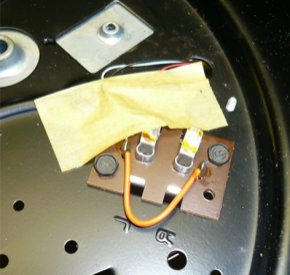 Before (3 wire floating ground) |
 After (4 wire ground looped) |
• Tracking force. Many modern magnetic cartridges track too light to use in a record changer. The record changer, depending on its age, requires more or significantly more tracking force to operate the automatic functions. The amount of tracking force required must be known in order to determine the feasibility of a magnetic cartridge conversion.
• Output voltage and equalization. Magnetic cartridges require a special preamp to be used in place of a ceramic or crystal cartridge. These are sold on this website and others. These typically have an output voltage of between 0.5v and 1.0v and this is not sufficient to replace crystal cartridges originally having outputs of 2 volts and above.
• Mounting considerations. Since most magnetic cartridges available today have half inch mounts, this restricts the record changers that might be converted. A model with a thin headshell and Tetrad cartridge is not a candidate for conversion.
As just discussed, this type of conversion should only be attempted by someone with a fair degree of technical prowess.
Stereo Cartridge Replacing a Monaural Cartridge
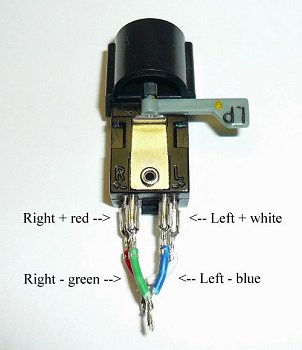 |
Monaural cartridges with a flip over needle are no longer made. If a single tip needle will suffice then a P51 series cartridge can be used. When a flip over needle is desired, a stereo cartridge can be used. All the other considerations (output voltage, tracking force, etc) discussed in other sections above must also be followed. The P228 sold on this website contains short wires with clips. Connect the Left and Right grounds together and attach to original ground wire, and then connect the Left and Right feeds together and attach to original feed wire (see picture). |
Playing Modern Records on Vintage Gear
Vintage record players have a style and sound all their own but its important also to understand their limitations before spending money on a repair or restoration. Older players from the 1950's even if outfitted with modern cartridges, may not have the refinement in the rest of the mechanism to play the most recently made records without some skipping. Later era record players, those that were in the higher price ranges when new, and those with magnetic cartridges will do better.
|
V-M Audio Enthusiasts -37530 E. Meadowhill Dr. - Northville, MI
48167
|